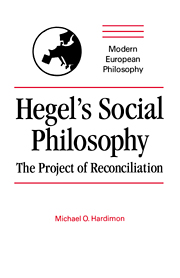Book contents
- Frontmatter
- Contents
- Acknowledgments
- List of abbreviations
- Introduction
- Part I An approach to Hegel's project
- Part II The project of reconciliation
- 4 The anatomy of the project
- 5 Individuality and social membership
- 6 The family, civil society, and the state
- 7 Divorce, war, and poverty
- Conclusion
- Selected bibliography
- Index
4 - The anatomy of the project
Published online by Cambridge University Press: 10 December 2009
- Frontmatter
- Contents
- Acknowledgments
- List of abbreviations
- Introduction
- Part I An approach to Hegel's project
- Part II The project of reconciliation
- 4 The anatomy of the project
- 5 Individuality and social membership
- 6 The family, civil society, and the state
- 7 Divorce, war, and poverty
- Conclusion
- Selected bibliography
- Index
Summary
In the preceding chapter, we considered the basic concept of Hegel's project. In this chapter we consider the project's basic elements and structure. This will involve gathering together elements considered in the previous chapters. The present chapter consists of five sections. Section I specifies the project's aim, who gets reconciled, and what they get reconciled to. Section II explains why the project is necessary. Section III clarifies how the project proceeds. Section IV explains how the project is possible. Finally, in Section V, we step back and consider how the project can be seen as involving a process of self-transformation.
The project's aim, its subject, and its object
I begin by considering the aim of Hegel's project, who gets reconciled, and to what.
1. The aim is, of course, reconciliation (Versöhnung). Hegel seeks to reconcile his contemporaries to the modern social world. He seeks to enable them to overcome their alienation and be at home in the social world.
One might wonder whether this aim is distinctive. After all, reconciliation can be understood in various ways. If it is understood in the most general way – as the aim of showing that modern institutions are worthy of acceptance – then almost every modern political philosopher (e.g., Hobbes, Locke, Rousseau, and Kant) can be regarded as implicitly committed to this claim. And so Hegel's project might not seem very different from the tradition of modern political philosophy.
- Type
- Chapter
- Information
- Hegel's Social PhilosophyThe Project of Reconciliation, pp. 127 - 143Publisher: Cambridge University PressPrint publication year: 1994

